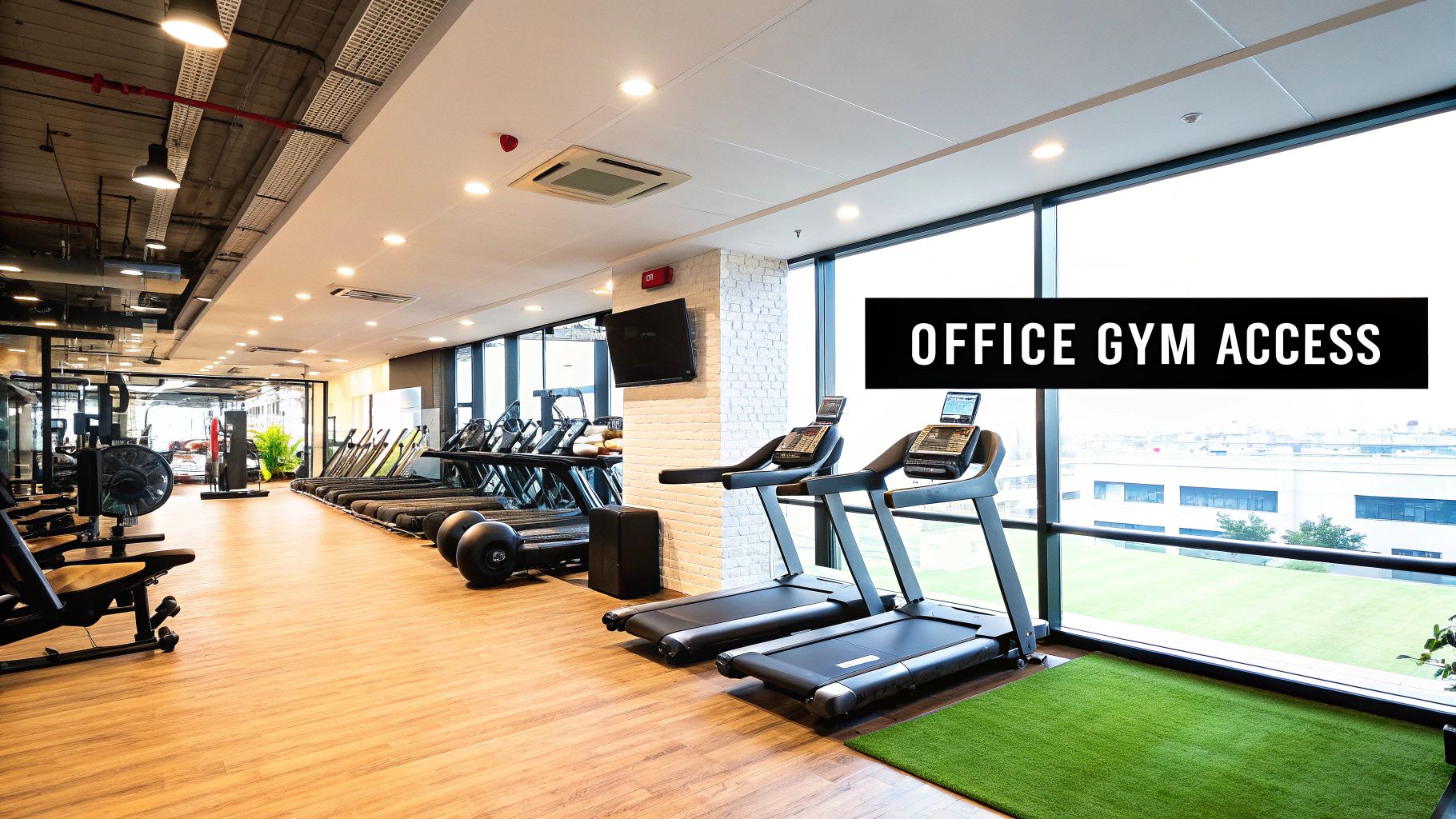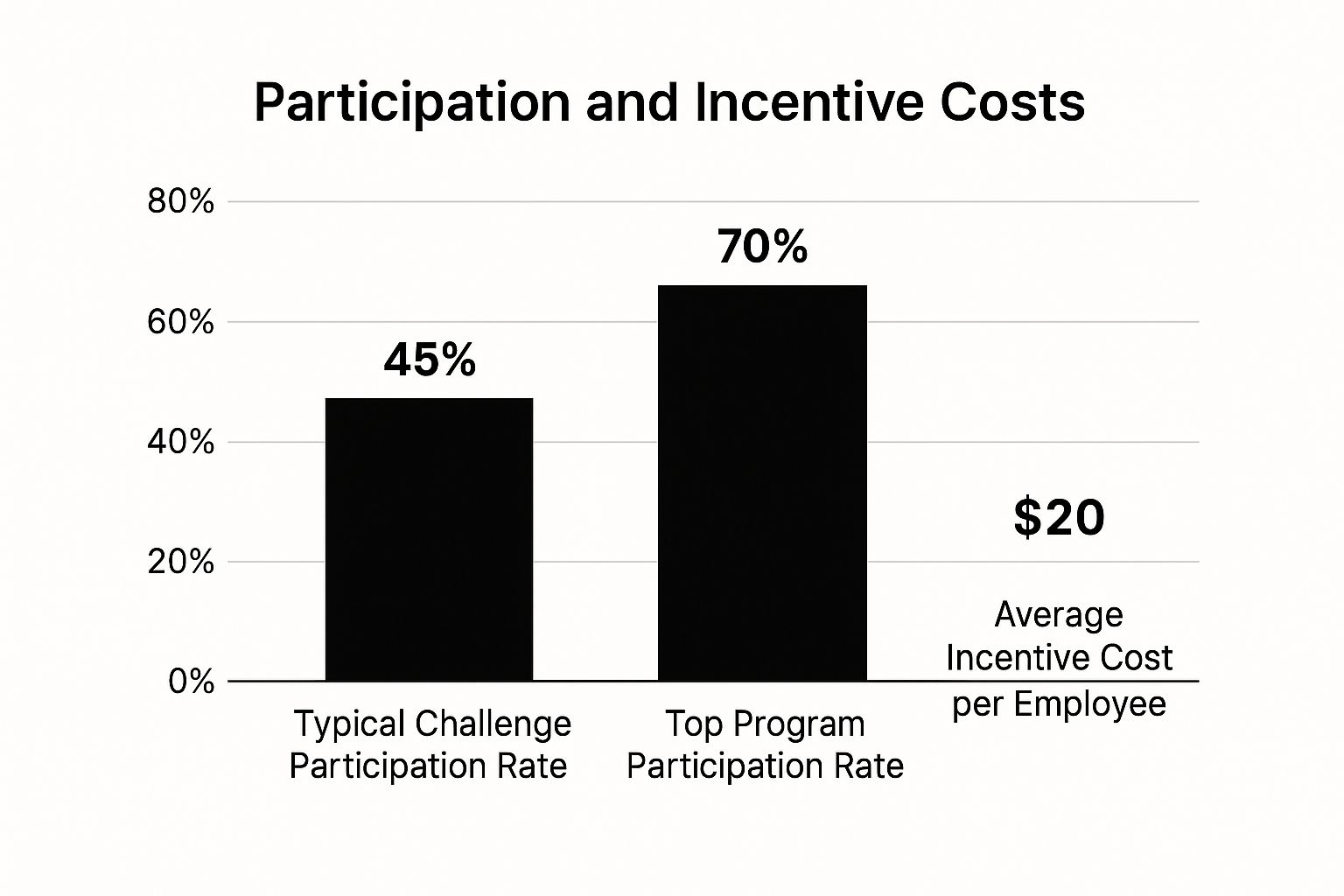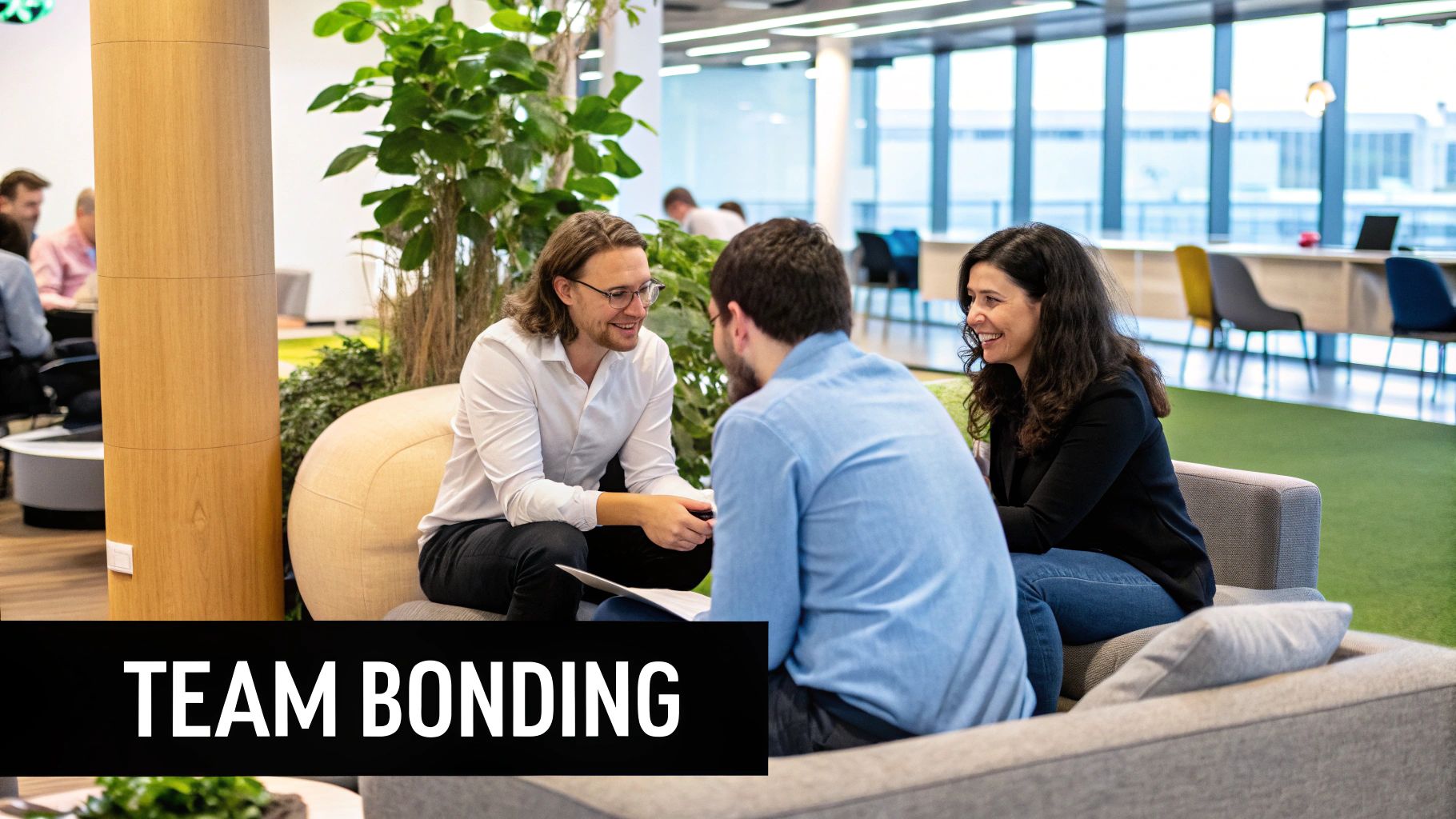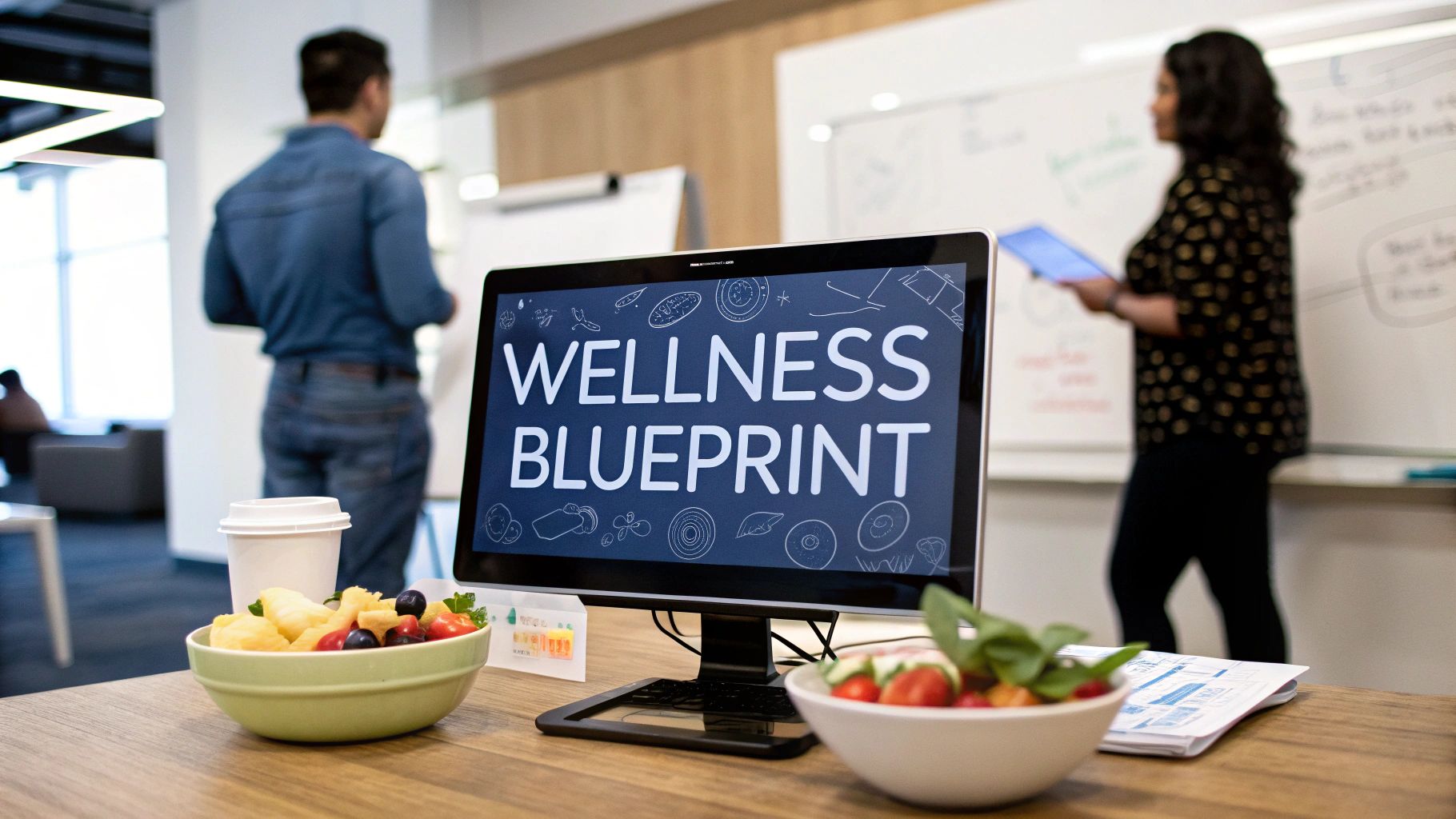In today's competitive landscape, attracting and retaining top talent requires more than just a competitive salary. A truly supportive work environment invests in the holistic wellbeing of its employees, recognizing that health extends far beyond physical fitness. The most effective corporate wellness programs are strategic initiatives that address physical, mental, financial, and social health, leading to a more engaged, resilient, and productive workforce.
This guide moves beyond surface-level perks to provide a deep dive into eight powerful workplace wellness program examples. We will dissect the strategy behind each one, offering actionable insights and replicable methods that companies of any size can adapt to build a thriving organisational culture. For a deeper dive into real-world applications and what's trending, consider these 7 Inspiring Workplace Wellness Program Examples for 2025.
From comprehensive mental health support to financial education and community-building initiatives, you'll gain a clear understanding of what works and why. We will explore how to implement these ideas effectively, ensuring they deliver genuine value to your employees and a tangible return on investment for your organisation. This is your blueprint for creating a wellness strategy that fosters a healthier, happier, and more high-performing team.
1. On-Site Fitness Centers and Gym Membership Programs
On-site fitness centres and gym membership programs are foundational workplace wellness program examples that directly support employee physical health. These initiatives lower the barriers to exercise, such as cost and commute time, by providing convenient access to fitness facilities. Companies can either build a dedicated gym on their premises or offer subsidised memberships to local fitness clubs, making it easier for employees to integrate physical activity into their daily routines.

This approach is highly visible and signals a strong corporate commitment to employee well-being. By removing logistical hurdles, employers empower their teams to build healthier habits, which can lead to reduced stress, increased energy, and fewer health-related absences.
Strategic Breakdown
- Pioneering Example: Google’s on-campus fitness centres are a prime example, offering state-of-the-art equipment, group classes, and even swimming pools. This turns the workplace into a holistic wellness hub.
- Flexible Model: Asana demonstrates a modern, flexible approach by providing fitness stipends and ClassPass memberships. This model caters to diverse preferences and supports remote or hybrid employees who cannot access an on-site facility.
- Brand Alignment: Companies like Nike and REI seamlessly integrate fitness into their corporate culture. Their on-site gyms, yoga studios, and sports courts reinforce their brand identity and attract talent who share those values.
Key Insight: The most successful programs offer choice. Combining on-site options with flexible stipends or partnerships accommodates different work arrangements, fitness preferences, and comfort levels, maximising participation and impact.
Actionable Takeaways
To implement a similar program, consider these steps:
- Assess Employee Interest: Before investing, use surveys to gauge interest and determine what types of facilities or classes your employees would actually use.
- Start with Partnerships: If building an on-site centre is not feasible, partnering with local gyms or wellness platforms like ClassPass for Business is a cost-effective alternative.
- Support Remote Staff: Ensure inclusivity by offering virtual fitness classes or wellness stipends that remote and hybrid employees can use for their preferred activities.
- Promote and Measure: Consistently communicate the program's benefits through internal channels. Track usage data and collect feedback to refine your offerings over time.
2. Mental Health and Employee Assistance Programs (EAPs)
Mental health support and Employee Assistance Programs (EAPs) are critical workplace wellness program examples that focus on psychological well-being. These programs offer confidential counselling, therapy, and support services to help employees and their families navigate personal and work-related challenges. EAPs address a wide spectrum of issues, including stress, anxiety, depression, substance use, and financial concerns, by connecting staff with licensed professionals.
This approach demonstrates a deep commitment to an employee's total health, creating a culture where seeking help is destigmatised and supported. By providing accessible mental health resources, organisations can foster resilience, reduce absenteeism, and improve overall productivity and morale.
Strategic Breakdown
- Pioneering Example: Starbucks set a new standard by partnering with Lyra Health to offer all its partners (employees), including part-time staff, 20 free therapy sessions annually. This inclusive model removes significant cost and access barriers.
- Flexible Model: Microsoft expanded its EAP to provide more free counselling sessions and introduced "well-being days." This hybrid approach combines direct professional support with the flexibility for employees to take proactive rest.
- Brand Alignment: Unilever integrated mental wellness directly into its culture with mental health first aid training and subscriptions to mindfulness apps. This aligns with its brand focus on holistic well-being and responsible business practices.
Key Insight: The most effective mental health initiatives are proactive, not just reactive. Combining confidential EAP services with cultural changes, such as manager training and mental health days, creates a supportive ecosystem that normalises mental health conversations and encourages early intervention.
Actionable Takeaways
To implement a similar program, consider these steps:
- Select a Comprehensive Provider: Choose an EAP partner like Lyra Health or Modern Health that offers diverse, licensed professionals and multiple access methods, including in-person, video, and text-based therapy.
- Emphasise Confidentiality: Promote the program regularly through internal communications, consistently stressing that all services are completely confidential to build trust and encourage use.
- Train Leadership: Equip managers and leaders to recognise signs of mental distress and guide employees toward available EAP resources without overstepping professional boundaries.
- Promote and Measure: Create awareness campaigns to reduce stigma and communicate the value of the EAP. Track anonymised utilisation rates and gather feedback to ensure the program meets employee needs.
3. Nutrition and Healthy Eating Programs
Workplace nutrition programs encourage healthy eating habits by providing education and easy access to nutritious foods. These initiatives recognise that proper nutrition is fundamental to physical health, mental clarity, and sustained energy. Programs range from providing fresh fruit to comprehensive approaches like nutrition counselling, healthy cafeteria options, and educational workshops on meal planning.

By making healthy choices the most convenient choices, employers can significantly influence daily habits. These programs directly contribute to a more focused and productive workforce while demonstrating a deep investment in long-term employee health.
Strategic Breakdown
- Holistic Integration: Google’s famous free gourmet meals showcase this strategy perfectly. By offering professionally prepared, healthy, and clearly labelled options, they embed nutrition directly into the workplace experience.
- Brand-Aligned Offerings: Driscoll's, the berry company, provides fresh berries to its employees and hosts nutrition sessions. This aligns the wellness program with its core product, reinforcing brand identity and values.
- Hyper-Local Partnerships: Zillow partners with local farms to provide weekly fresh produce boxes to employees. This model supports local agriculture while delivering high-quality, nutritious food directly to its team.
Key Insight: The most effective nutrition programs focus on empowerment over restriction. They provide education, access, and positive reinforcement, creating an environment where healthy eating is an easy and appealing choice rather than a mandate.
Actionable Takeaways
To implement a similar program, consider these steps:
- Start with Simple Access: Begin by offering complimentary fruit baskets or stocking break rooms with healthy snacks. This is a low-cost way to gauge interest and make an immediate impact.
- Educate and Empower: A foundational element of any successful nutrition program is empowering employees with knowledge. Offer workshops or resources on topics like how to read food labels effectively to build lasting skills.
- Support All Work Models: Extend benefits to remote staff through healthy snack box deliveries or stipends for grocery services, ensuring inclusivity for your entire team.
- Make Healthy the Default: Redesign cafeteria layouts to make salads and plant-based meals more prominent than less healthy alternatives. Use clear nutritional labelling to help employees make informed choices.
4. Wellness Challenges and Incentive Programs
Wellness challenges and incentive programs use gamification and rewards to motivate employees toward healthier habits. These initiatives are designed as structured, time-limited campaigns where individuals or teams work to achieve specific goals, such as increasing step counts, improving sleep, or practising mindfulness. By adding elements of friendly competition and tangible rewards, these programs tap into behavioural science to boost engagement and make wellness fun.
This approach creates a sense of shared purpose and camaraderie, transforming individual health goals into a collective team effort. Incentive programs, which offer rewards like gift cards, extra time off, or reductions in insurance premiums, provide a powerful nudge to encourage participation and sustained effort. As some of the most engaging workplace wellness program examples, they are highly effective at building momentum and positive habits.
This bar chart visualizes key metrics related to the participation and cost of typical wellness incentive programs.

The data highlights that while a 45% participation rate is average, top-tier programs can achieve 70% engagement with a modest incentive cost, demonstrating the high ROI of a well-designed challenge.
Strategic Breakdown
- Gamified Engagement: Virgin Pulse powers challenges for global companies like Shell and Barclays, using a points-based system where employees track activities to earn rewards. This gamified platform turns daily wellness into an interactive and motivating experience.
- Corporate Social Responsibility: Blue Cross Blue Shield created a step challenge where employee activity translated into charitable donations. This model connects personal well-being to a greater social cause, significantly boosting intrinsic motivation.
- Financial Incentives: Humana’s "Go365" program is a leading example of linking wellness activities directly to financial rewards. Employees earn points for check-ups, fitness activities, and educational modules, which can be redeemed for prizes or lower insurance premiums.
Key Insight: The most impactful programs focus on participation over pure outcomes. By rewarding effort and creating inclusive, team-based challenges, companies foster a supportive environment where everyone feels encouraged to join, regardless of their current fitness level.
Actionable Takeaways
To launch an effective challenge, consider these steps:
- Define Clear, Achievable Goals: Design challenges around specific, measurable actions (e.g., 10,000 steps a day for four weeks) rather than vague outcomes to keep participants motivated.
- Offer a Variety of Challenges: Rotate themes to cover different dimensions of wellness, including physical activity, nutrition, mental health, and financial literacy, to maintain long-term engagement.
- Leverage Technology: Use platforms like Wellable or Fitbit Corporate Wellness to simplify tracking, leaderboards, and communication, making participation seamless for all employees.
- Prioritise Privacy and Inclusivity: Ensure all health data is kept confidential and participation is voluntary. Offer multiple ways to earn points so employees of all abilities can engage meaningfully.
5. Flexible Work Arrangements and Work-Life Balance Programs
Flexible work arrangements are among the most impactful workplace wellness program examples, shifting the focus from rigid schedules to employee autonomy and trust. These programs give employees greater control over when, where, and how they work through options like remote work, flexible hours, and compressed workweeks. By acknowledging that employees have lives outside of their jobs, companies can directly combat burnout and stress.
This approach demonstrates a commitment to holistic well-being, enabling team members to manage personal responsibilities, reduce commuting time, and align work with their peak productivity hours. Ultimately, this leads to higher engagement, improved morale, and better talent retention.
Strategic Breakdown
- Pioneering Example: GitLab operates as a fully remote company with a transparent handbook that codifies its flexible, asynchronous culture. This model proves that large-scale organisations can thrive without a central office.
- Flexible Model: Patagonia empowers its employees to "go surfing when the waves are good," a policy that embodies its brand and deep-seated trust in its team. This flexibility is a core part of its work-life balance culture.
- Brand Alignment: Netflix’s unlimited paid time off policy aligns with its brand identity of "freedom and responsibility." It trusts employees to manage their own time, reinforcing a culture of high performance and mutual respect.
Key Insight: True flexibility isn't just about location; it's about trusting employees to manage their time and energy effectively. The most successful programs focus on outcomes over hours logged, empowering individuals to integrate work and life seamlessly.
Actionable Takeaways
To implement a similar program, consider these steps:
- Define Clear Expectations: Establish and document clear guidelines for communication, availability (e.g., core hours), and performance metrics to ensure everyone is aligned.
- Invest in Technology: Equip your teams with the necessary collaboration tools (like Slack, Asana, or Microsoft Teams) and infrastructure to support seamless remote and hybrid work.
- Train Your Managers: Provide training for leaders on how to manage remote and flexible teams effectively, focusing on results-based evaluation rather than micromanagement.
- Lead by Example: Encourage leadership to model healthy boundaries by taking time off and utilising flexible work options. This helps eliminate guilt and promotes widespread adoption.
6. Preventive Health Screening and Biometric Programs
Preventive health and biometric screening programs empower employees to take a proactive role in managing their well-being. These initiatives offer on-site or third-party assessments that measure key health indicators such as blood pressure, cholesterol, glucose levels, and Body Mass Index (BMI). By providing a clear snapshot of their current health status, employees can identify potential risks early and take informed action.
These programs demonstrate a deep investment in employee health beyond surface-level perks. Companies often pair screenings with confidential health risk assessments (HRAs) and follow-up resources like health coaching, creating a supportive pathway from awareness to meaningful behaviour change. This data-driven approach helps both employees and employers understand health trends and focus wellness efforts where they are needed most.
Strategic Breakdown
- Pioneering Example: Johnson & Johnson's comprehensive 'Health & Wellness' program has long included biometric screenings. This early detection and prevention focus has been credited with significant healthcare cost savings and a healthier, more productive workforce.
- Incentive-Driven Model: Safeway's 'Healthy Measures' program links voluntary participation in biometric screenings to tangible rewards, such as discounts on health insurance premiums for meeting specific health targets. This incentivises engagement and encourages sustained healthy habits.
- Integrated Care Model: Lincoln Industries offers on-site health clinics where employees can receive preventive screenings and primary care. This model removes barriers like travel and appointment scheduling, making it exceptionally convenient for employees to stay on top of their health.
Key Insight: The success of biometric screening programs hinges on trust and follow-through. It is crucial to guarantee data privacy by using a third-party vendor and to provide clear, actionable next steps and resources, such as health coaching, to help employees act on their results.
Actionable Takeaways
To implement a similar program, consider these steps:
- Prioritise Privacy: Partner with a reputable, independent third-party provider to conduct screenings and manage data. Clearly communicate your robust privacy and data security policies to build employee trust.
- Offer Meaningful Incentives: Encourage voluntary participation with positive incentives like premium reductions, wellness stipends, or paid time off, rather than penalties.
- Provide Comprehensive Follow-Up: Do not just provide data; offer resources. Connect employees with health coaches, educational materials, or healthcare professionals to help them understand their results and create an action plan.
- Ensure Legal Compliance: Adhere strictly to all regulations, including HIPAA, the ADA, and GINA, to protect employee rights and avoid legal risks.
7. Financial Wellness and Education Programs
Financial wellness and education programs are essential workplace wellness program examples that address a primary source of employee stress: personal finances. These initiatives provide the tools, resources, and support necessary for employees to manage their money effectively, reduce debt, and plan for their future. By tackling financial anxiety head-on, employers can improve focus, reduce absenteeism, and boost overall morale.
This type of program demonstrates a deep commitment to an employee's holistic well-being, acknowledging that life outside of work significantly impacts performance within it. Offerings can range from educational workshops and confidential one-on-one coaching to tangible benefits like student loan repayment assistance or emergency savings support.
Strategic Breakdown
- Holistic Integration: PwC offers a comprehensive program that includes student loan paydown benefits and free access to financial advisors. This integrated approach has led to 77% of their employees reporting that they feel financially healthy.
- Life Stage Support: Starbucks’ College Achievement Plan, which provides full tuition coverage for bachelor’s degrees, is a powerful financial wellness tool that addresses long-term financial burdens and career growth simultaneously.
- Practical Assistance: Prudential Financial created an emergency savings program with employer matching. This directly addresses the common issue where employees lack a financial cushion for unexpected expenses, a major source of acute stress.
Key Insight: The most effective financial wellness programs combine education with tangible, practical solutions. While workshops are valuable, benefits like student loan assistance or matched savings funds provide direct relief and build significant employee loyalty.
Actionable Takeaways
To implement a similar program, consider these steps:
- Assess Financial Stressors: Use confidential surveys to understand your employees' primary financial concerns, such as student debt, retirement planning, or daily budgeting.
- Partner with Unbiased Experts: Collaborate with reputable financial wellness platforms or non-profit organisations to provide education that is free from sales pressure or product promotions.
- Offer Confidential Support: Ensure one-on-one financial counselling is available and strictly confidential to encourage employees to seek personalised help without fear of judgement.
- Integrate and Communicate: Weave financial wellness resources into your overall benefits package and communicate them year-round, not just during open enrolment. Use multiple channels like webinars, articles, and workshops to reach everyone.
8. Social Connection and Community Building Programs
Social connection and community building programs are workplace wellness program examples designed to foster meaningful relationships and a strong sense of belonging among employees. These initiatives recognise that social well-being is a critical pillar of overall health, directly impacting mental resilience, job satisfaction, and employee retention. By creating structured and informal opportunities for connection, companies can combat loneliness and build a supportive, collaborative culture.

In an era where remote and hybrid work can lead to isolation, intentionally building a community is essential. These programs move beyond simple work tasks to unite people through shared interests, volunteerism, and social events, strengthening the organisational fabric.
Strategic Breakdown
- Culture-Driven Example: Salesforce’s ‘Ohana Culture’ is a prime example, treating employees, customers, and partners like a family. They support this with extensive Employee Resource Groups (ERGs), paid volunteer time, and large-scale community events that reinforce a deep sense of connection.
- Design-Led Model: Pixar strategically designed its head office with a central atrium, positioning key amenities like the mailroom and café to encourage spontaneous, unplanned interactions between employees from different departments. This architectural choice actively engineers social connection.
- Brand-Aligned Approach: Patagonia’s "Let My People Go Surfing" philosophy encourages employees to connect through shared outdoor activities. This not only builds strong team bonds but also authentically aligns with the company’s brand identity, attracting talent who live the brand’s values.
Key Insight: The most effective community programs are employee-driven and executive-supported. Empowering employees to create their own interest groups and ERGs ensures authenticity and relevance, while executive sponsorship provides the necessary resources and legitimacy to thrive.
Actionable Takeaways
To implement a similar program, consider these steps:
- Enable Employee-Led Groups: Provide a framework and resources for employees to form clubs or ERGs based on shared interests or identities. Support them with a budget and executive sponsorship.
- Integrate Connection into Onboarding: Design onboarding processes that prioritise building social networks for new hires from day one, connecting them with mentors, team members, and social groups.
- Prioritise Inclusivity: Ensure social activities cater to a diverse range of interests, abilities, and comfort levels. Offer a mix of virtual and in-person events, and avoid activities that might exclude certain groups.
- Dedicate Time and Space: Carve out time during the workday for social events or volunteering. Design physical and digital spaces that encourage informal communication and spontaneous collaboration.
Workplace Wellness Program Comparison: Top 8 Examples
| Program Type | Implementation Complexity | Resource Requirements | Expected Outcomes | Ideal Use Cases | Key Advantages |
|---|---|---|---|---|---|
| On-Site Fitness Centers and Gym Membership | High (facility build, staffing) | High initial and ongoing costs | Increased physical activity, reduced health costs | Companies with large campuses, on-site staff | Convenient access, morale boost, team building |
| Mental Health and EAPs | Moderate (provider coordination) | Moderate (provider fees, promotion) | Improved mental wellbeing, reduced absenteeism | All organizations, especially with remote workers | Confidential support, stigma reduction |
| Nutrition and Healthy Eating Programs | Low to Moderate | Moderate to high (cafeteria, snacks) | Better nutrition, disease risk reduction | Offices with cafeterias or food services | Energy boost, chronic disease prevention |
| Wellness Challenges and Incentive Programs | Low to Moderate | Low to Moderate (platforms, rewards) | Increased engagement, behavior change | All organizations seeking engagement | Gamified motivation, low cost, remote-friendly |
| Flexible Work Arrangements and Work-Life Balance | Moderate to High | Moderate (tech, policy design) | Higher satisfaction, retention, reduced stress | Knowledge workers, remote/distributed teams | Improved work-life balance, talent attraction |
| Preventive Health Screening and Biometric Programs | Moderate to High | Moderate to High (screenings, coaching) | Early risk detection, health cost savings | Large employers with wellness budgets | Proactive health management, personalized data |
| Financial Wellness and Education Programs | Moderate | Moderate (education, counseling) | Reduced financial stress, improved retention | All organizations, financial stress common | Lifelong skills, low cost, broad appeal |
| Social Connection and Community Building | Low to Moderate | Low to Moderate (events, facilitation) | Increased engagement, reduced isolation | All workplaces, especially remote-inclusive | Strong culture, DEI support, high morale impact |
Building a Healthier Future: Your First Steps to a Thriving Workplace
The diverse workplace wellness program examples we’ve explored, from on-site fitness centres to comprehensive financial education, all point toward a single, powerful truth: the future of work is a healthy one. The era of wellness as a simple "perk" or a checkbox item is over. Today, a strategic, thoughtfully implemented wellness program is a non-negotiable component of a resilient, engaged, and high-performing organisational culture.
The most impactful initiatives share several core characteristics. They are holistic, recognising that an employee's wellbeing extends beyond physical health to encompass mental, financial, and social dimensions. They are also deeply personal, moving away from one-size-fits-all solutions towards flexible, customisable options that meet the real needs of a diverse workforce. As seen in the examples, success hinges on data, communication, and genuine leadership support.
From Inspiration to Implementation: Your Action Plan
Seeing these examples is inspiring, but turning inspiration into action is what creates real change. The key is to start small, measure your impact, and build momentum over time. You don't need a massive budget or a complete overhaul to begin making a difference.
Here are your actionable first steps:
- Gather Feedback: The most crucial first step is to listen. Deploy a simple, anonymous survey to understand your employees' biggest wellness challenges and what kind of support they would value most. Are they stressed about finances? Do they lack time for physical activity? Are they seeking better work-life balance? This data is your road map.
- Start with a Pilot Program: Based on your feedback, choose one high-impact, low-barrier initiative to pilot. This could be a four-week "step challenge," a series of webinars on mental health, or partnering with a local caterer to offer subsidized, healthy lunch options once a week. A pilot program allows you to test, learn, and demonstrate value before committing to a larger investment.
- Champion Communication: Clearly and consistently communicate the "why" behind your wellness initiatives. Frame them not as a corporate mandate, but as a genuine investment in your team's health and happiness. Celebrate small wins, share success stories, and actively solicit feedback to show that this is a collaborative effort.
Ultimately, the power of these workplace wellness program examples lies in their replicable strategies. By adopting a mindset of continuous improvement and employee-centric design, any organisation can build a program that not only boosts health outcomes but also becomes a cornerstone of its brand, a magnet for top talent, and a catalyst for sustainable success. Investing in your people is the most reliable investment you will ever make.
Ready to kickstart your company's nutrition program with a partner that understands flavour and health? Shawarma Moose offers delicious, authentic, and customizable corporate catering solutions that make healthy eating at work easy and exciting. Explore our catering options to fuel your team's wellbeing today: Shawarma Moose.

